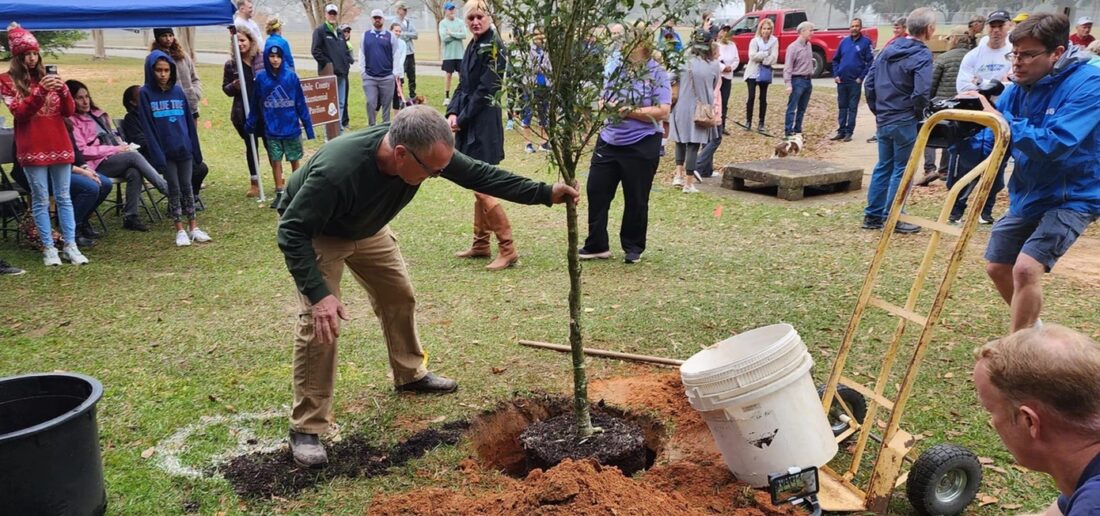On a rainy night, the lights in my house in Mobile, Alabama, started pulsing on and off and the fans began spinning too fast. I stepped outside to see if the rest of the block was also losing power. But no, my house was the only one convulsing as if haunted. Then the dishwasher set on fire.
When a lineman with Alabama Power arrived, he pointed at the neighbor’s linden tree, its branches hanging over the power line that ran from the street to our house, and declared it the culprit: The limbs had cut the line, sending a surge into my house. The worker ran a new line, carefully avoiding the foliage, until the neighbor showed up and gave him his blessing to trim a few branches.

In most places in the United States, power companies have the right to maintain lines by cutting back vegetation at their discretion. In general, that’s also true in Alabama, but in Mobile, where the trees are integral to the city’s identity and people’s arboreal love is longstanding and fanatical, tree-cutting gets a little more complicated. A number of new regulations, committees, and general social pressure have been protecting Mobile’s trees.
The result is that the city is a fast-growing woody wonderland. Live oaks arch over streets to make leafy tunnels, magnolias rise dark and lush, and leggy palms sway. Otherwise unremarkable streets and busy boulevards are made magnificent by the greenery. Sometimes the trees are so big and solid that other trees grow in them. Near my house, there’s an oak with a cedar growing in its upper branches. Resurrection ferns green the limbs after a good rain, then curl up into husks during dry spells.
The oldest living landmark in the city is a tree, the Duffee Oak, which is estimated to be about three hundred years old. Its limbs are so spectacularly heavy that they’ve been braced by two-by-four supports lest they collapse. The trees are keepers of the city’s history. One, the Boyington Oak, is named after Charles Boyington, who was executed and buried in the city in 1835. Maintaining his innocence to the end, he prophesied an oak would grow out of his heart as proof. That oak still stands.
Mobile was the first Alabama city to receive the “Tree City USA” designation from the Arbor Day Foundation, forty-five years ago, and Mobilians are intensely proud of that heritage. Meetings of the city’s Tree Commission, which is charged with protecting the trees, get very heated. Within the last decade, a series of incidents inspired Mobilians to act: In 2015, nine live oaks were removed near a historic downtown square to make room for a hotel. In 2016 a large cedar was felled in a public park and displayed as a prop at a rally for the then president-elect, Donald Trump. In 2019, sixty live oaks were cut down during the reconstruction of a major thoroughfare in the city and replaced with small saplings. In each instance, citizens rose up in defense of the trees. In one case, a woman chained herself to an oak.
In response, in 2021, the city adopted new regulations for tree protection. The updated ordinance is in line with the latest American National Standards Institute Tree Care guidelines, which outline best practices for tree maintenance. The city established nine tree trails, streets with “significant historic and aesthetic value because of the trees adjoining the land.” On both public and private land, anyone wanting to trim or remove a heritage tree—one of eight species designated as such once they reach a certain size—is limited by city codes and must seek permits. Historic neighborhoods like mine have even more stringent guidelines.

Electrical services have easements to trim back vegetation, but according to the new rules, utilities must coordinate with the city before doing work that might affect trees along tree trails. Even outside those protected areas, the lineman told me that he approaches each job with caution. He said linemen keep a list of the one hundred oldest trees and dare not touch them. Beth Thomas, a spokesperson for Alabama Power, says the company has no such official list, but conceded they do “work very hard to balance providing safe and reliable power for our customers with preserving the trees to the best of our ability.” She added, “We try to work carefully with customers, particularly on some of these older trees that are obviously a hallmark of our city.” An Alabama Power representative attends most Tree Commission meetings.
Plus, people are always watching. The lineman I spoke with told me he and his colleagues regularly encounter citizens recording their every move with phones. When the utility’s maintenance is too aggressive, those same citizens complain. Loudly.
As I was writing this, I stepped out to investigate the new line that runs to my house. A limb is resting on it, touching. The power line on the street weaves in and out of verdant canopy. A new person recently moved into the neighboring house and she came out to chat. She followed my gaze to the cables. “Shouldn’t those trees be trimmed back?” she asked. Time will tell. But for now, the trees are gloriously spread.








